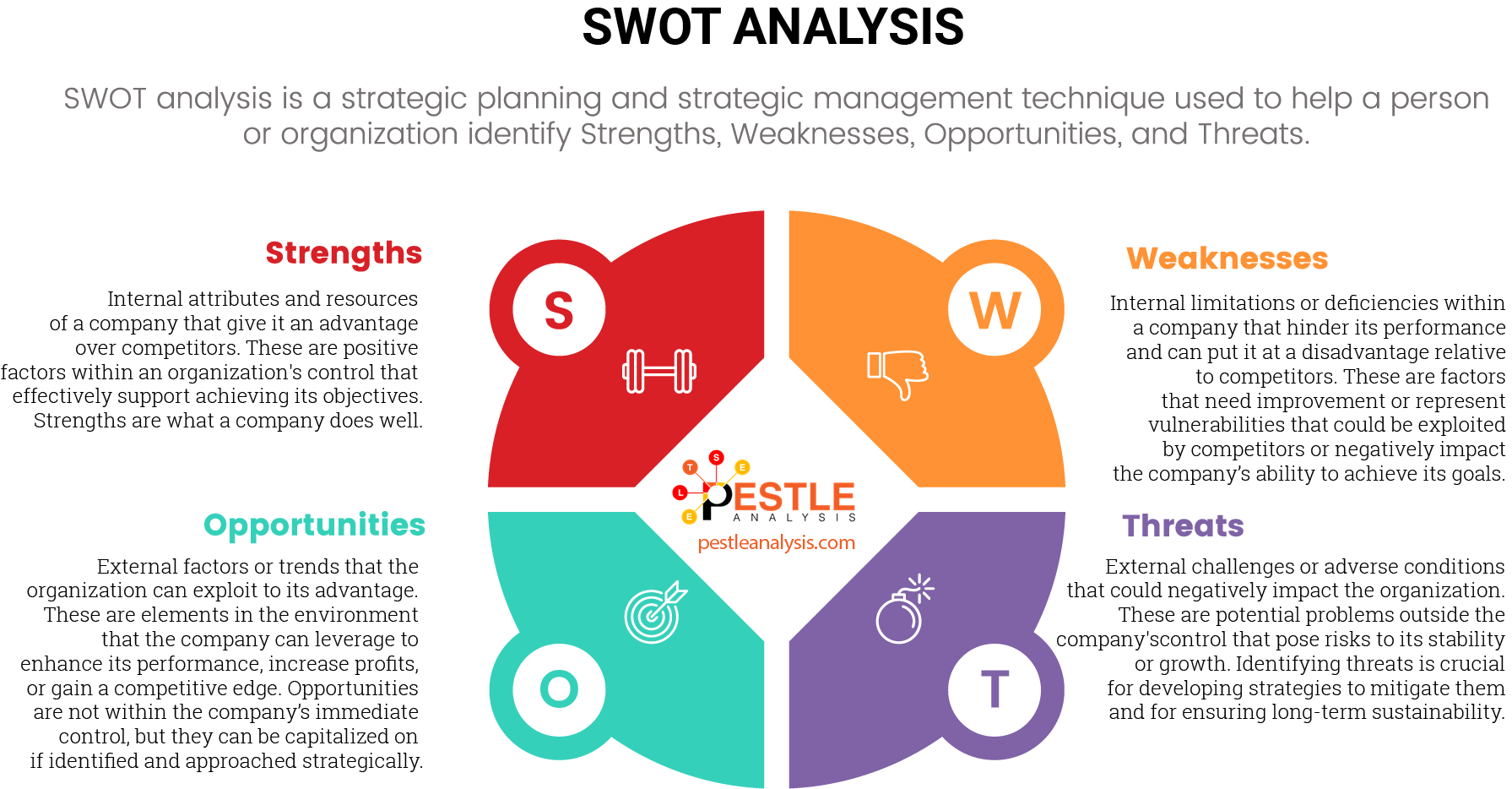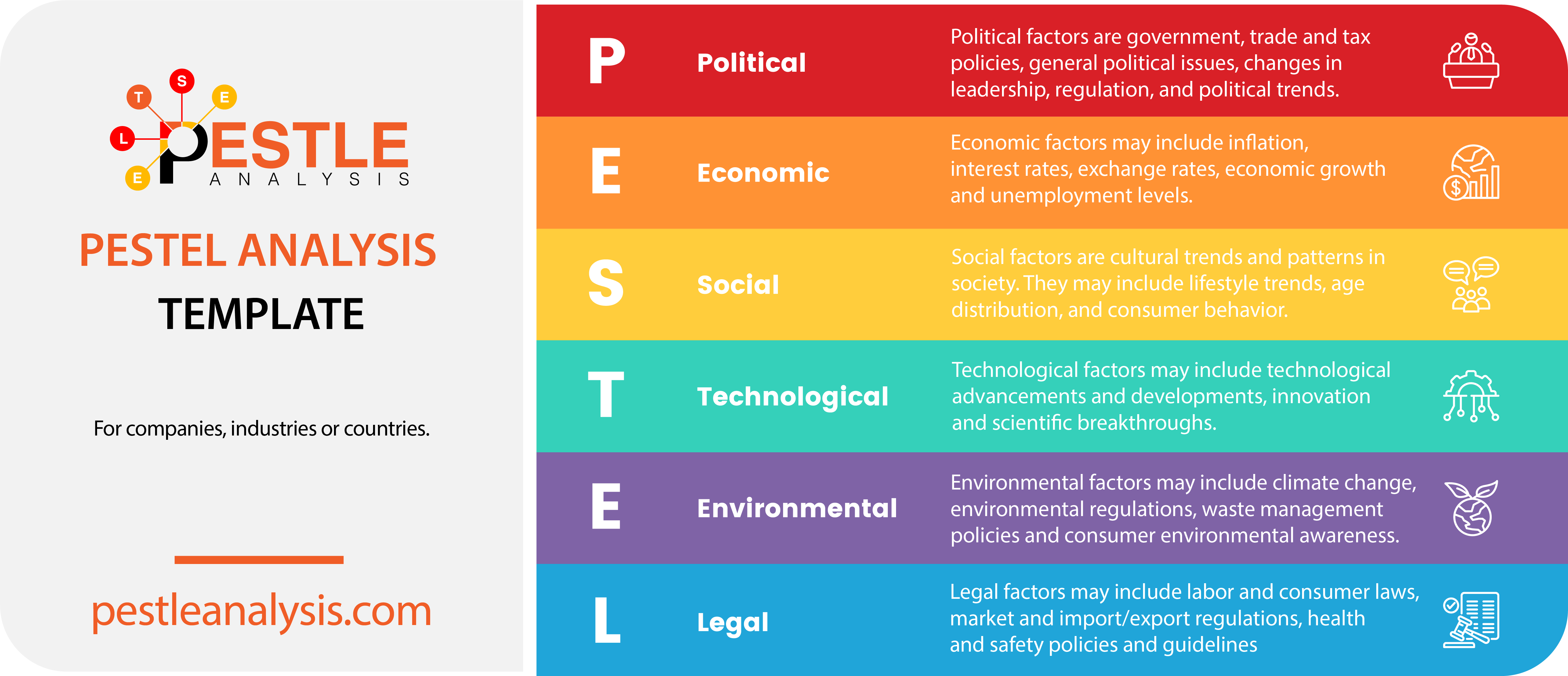Find out the differences between internal and external analysis and how you can use SWOT and PESTLE models to accomplish both.
Strategic management is a popular method for running businesses which involves an analytical approach to setting goals and managing resources. Like strategic planning, strategic management often involves a good dose of business analysis. Broadly speaking, this business analysis can be categorized as either internal or external.
In this short guide, we'll walk you through the differences between internal and external analysis and show you how you can use SWOT and PESTLE models to accomplish both.
Internal Analysis for Strategic Management
What Is Internal Analysis?
Let's start with internal analysis. As the name suggests, internal analysis focuses on evaluating all aspects of the organization itself. Although internal analysis can sometimes take into account the actions of external organizations or market-wide shifts, it is largely related to the inherent traits of the organization at hand.
For example, internal analysis can allow you to identify both strong and weak aspects of your organization, without taking into account the performance of external organizations.
Here's another way to think about internal analysis: if your organization was the only one that existed — meaning your organization had no competition — and your business environment was entirely neutral — meaning it didn't in any way affect your organization — then what factors would you consider when analyzing your organization?
Why Is Internal Analysis Important?
In the context of strategic management, internal analysis is crucial for a few reasons. Your organization might be spending too much in some areas due to internal inefficiencies, or, alternatively, your organization could be leaving money on the table. The only way to reveal these things — and get a true understanding of how resources are being used in your organization — is by means of internal analysis.
Why Use SWOT as a Tool?

The SWOT model is an excellent tool for internal analysis, since it encourages you to think about your organization and only your organization. The acronym SWOT stands for Strengths, Weaknesses, Opportunities, and Threats, which are the four factors you take into account during SWOT analysis as you create the SWOT table.
As you can see, the first two of these factors — Strengths and Weaknesses — are very much internal. Neither your competitors nor your external business environment can affect what your organization does well and what your organization does poorly: those things are entirely up to you.
With the latter two factors — Opportunities and Threats — you could argue that SWOT analysis doesn't have an entirely internal focus. However, that simply depends on how you use it. If you choose to ignore external factors (such as competitive rivalry, material costs, or government regulations), the Opportunities and Threats categories can still provide valuable insight to the internal aspects of your organization, in the context of strategic management.
Getting Started with SWOT
SWOT analysis is as easy as it sounds: listing and evaluating the Strengths, Weaknesses, Opportunities, and Threats affecting your organization. Trying to come up with these factors isn't always so easy; it takes a lot of brainstorming.
For more information, be sure to read our complete guide to conducting a SWOT analysis.
External Analysis for Strategic Management
What Is External Analysis?
Let's switch gears and talk about external, or environmental, analysis. Unlike internal analysis, external analysis is less about the organization itself, and more about its business environment (including its competitors). Again: the term is mostly self-explanatory — looking at external business analysis factors instead of internal ones.
So, what exactly would an example of an external factor be? The number of new competitors entering your industry, the cost of materials used to manufacture your products, or the regulatory frameworks set out by governments — these are all examples of variables which are out of your organization's control, and should be taken into account in external analysis.
One helpful way to tell whether a business analysis factors is external or not is to ask "does this factor apply to other organizations?" For example, an increased tax rate applies all organizations — not just yours — so you know it's an external factor.
Why Is External Analysis Important?
As you might expect, external analysis is also very important in the context of strategic management. When evaluating your organization's goals and resources, you absolutely need to look at the surrounding business environment. In a perfect world, it would be enough just to look inside your organization; in the real world, you need to be conscious of external forces that might affect your business' operations and throw you off course.
Why Use PESTLE as a Tool?

For analyzing external factors, the PESTLE model should be your tool of choice. PESTLE stands for Political, Economic, Sociocultural, Technological, Legal, and Environmental, which are the six categories of environmental factors you should take into account during business analysis (like in strategic management).
If you look closely, you'll see that these almost all of the factors that fall into these six categories aren't inherently related to your organization, but are related to the overarching business environment:
- Political. How are government decisions influencing your organization?
- Economic. How is the local or global economy influencing your organization?
- Sociocultural. How are changes in social and cultural norms influencing your organization?
- Technological. How is the advancement, presence, or lack of technology influencing your organization?
- Legal. How are legal issues influencing your organization?
- Environmental. How is the environment influencing your organization?
Getting Started with PESTLE
Similarly to SWOT analysis, using PESTLE analysis is surprisingly easy. Simply categorize the external factors affecting your business as Political, Economic, Sociocultural, Technological, Legal, or Environmental.
The challenge is finding those factors in the first place. It's helpful if you have some experience in your industry, which would give you a headstart on where to look. Otherwise, you'll need to do a lot of brainstorming and trawl through plenty of reports to find out which factors really affect your organization.
For more information on carrying out an external analysis like this, be sure to read our three-step guide to PESTLE analysis.
Internal and External Analysis in Strategic Management: Final Thoughts
Strategic management is a powerful way to run businesses. As a result of this approach's inherently analytical nature, it's important that you use both internal and external business analysis tools to make managerial decisions. You can do so by using the popular models of SWOT and PESTLE, which we have come to know and love in the world of business analysis.


